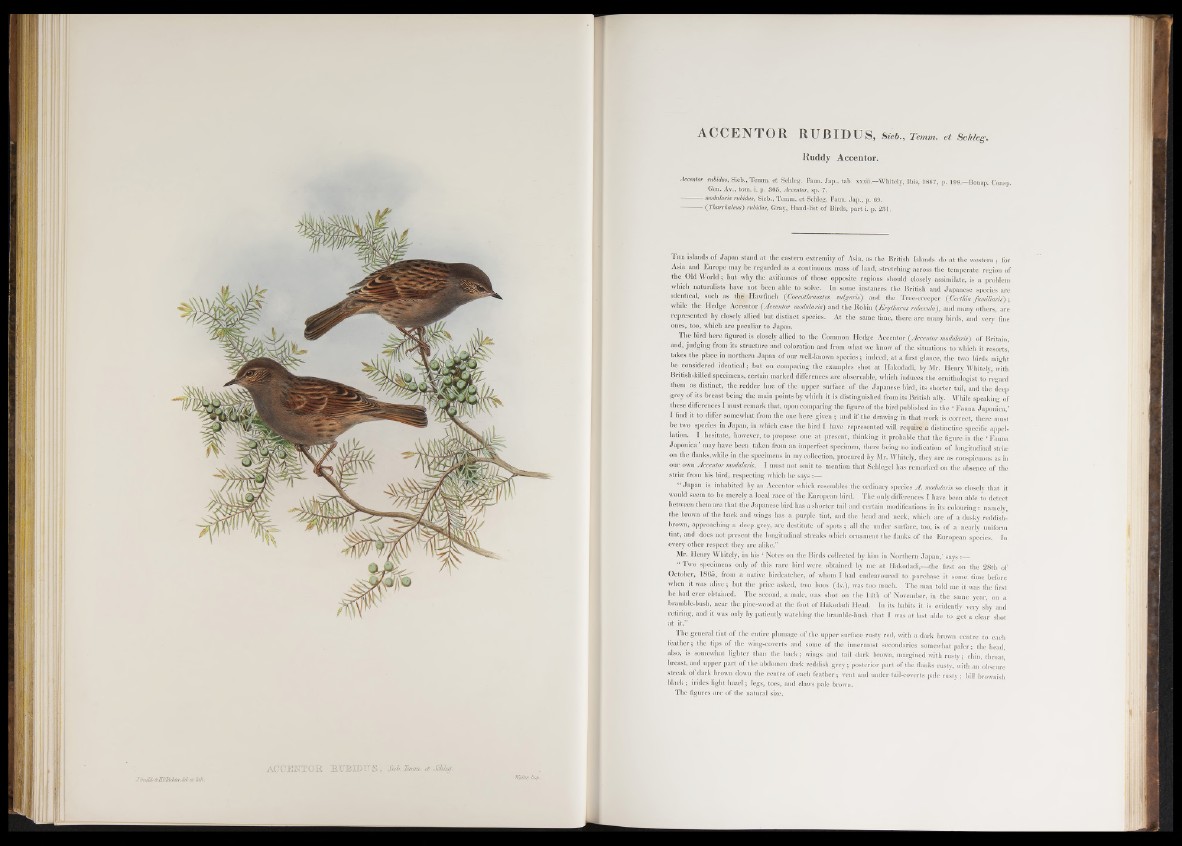
ACCEPTOR RURIBUS, Sieb, Jinm. a Schleg.
kEDEiekta-, ddti/Mu. g É Wdhzr,inp
ACCENTOR RUBIDUS, Sieb., Temm. et Schleg.
Ruddy Accentor.
Accentor rubidus, Sieb., Temm. et Schleg. Faun. Jap., tab. xxxii.—Whitely, Ibis, 1867, p. 198.—Bonap. Consp.
Gen. Av., tom. i. p. 305, Accentor, sp. 7.
----------modular is rubidus, Sieb., Temm. et Schleg. Faun. Jap., p. 69.
— - (Tharrhaleus) rubidus, Gray, Hand-list of Birds, part i. p. 231.
T h e islands of Japan stand at the eastern extremity of Asia, a® the British Islands do at the western ; for
Asia and Europe may be regarded as a continuous mass o f land, stretching across the temperate region of
the Old World ; but why the avifaunas o f those opposite regions should closely assimilate, is a problem
_ which naturalists hare not been able In some instances the British and Japanese species are
identical, such as th^s .Hawfinch ( Coccothraustes vulgaris) and the Tree-creeper ( Cert/iia familiaris);
while the Hedge Accentor (Accentor modularis) and the Robin j fB jd f e a » rubecuW), and many others, are
represented by closely allied but distinct species. At the same time, there are many birds, and very fine
ones, too, which are peculiar to Japan.
The bird here figured is closely allied to the Common Hedge Accentor (Accentor modularis) of Britain,
and, judging from its structure and coloration and from what we know of the situations to which it resorts,
takes the place in northern Japan of our well-known species; indeed, at a first glance, the two birds might
be considered identical; but on comparing the examples shot at Hakodadi, by Mr. Henry Whitely, with
British-killed specimens, certain marked differences are observable, which induces the ornithologist to regard
them as distinct, the redder hue of the upper surface of the Japanese bird, its shorter tail, and the deep
grey of its breast being the main points by which it is distinguished from its British ally. While speaking of
these differences I must remark that, upon comparing the figure of the bird published in the ‘ Fauna Japónica,’
I find it to differ somewhat from the one here given ! and if the drawing in that work is correct, there must
two species in Japau, in whicbcase the bird I have represented will reqüirifa distinctive specific appellation.
I hesitate, however, to propose one at present, thinking it probable that the figure in the 1 Fauna
Japónica’ may have been taken from an imperfect specimen, there being no indication o f longitudinal stria;
on the flanks, while in the specimens in m y collection, procured by Mr. Whitely, they are as conspicuous as in
our own Accentor modiilaris. I must not omit to mention that Schlegel has remarked on the absence of the
striae from his bird, respecting which he says
“ J aPan is inhabited by an Accentor which resembles the ordinary species A . modularis so closely that it
would seem to be merely a local race o f the European bird. The only differences I have been able to detect
between them are that the Japanese bird has a shorter tail and certain modifications in its colouring: namely
the brown o f the back and wings has a purple tint, and the head and neck, which are o f a dusky reddish-
brown, approaching a deep grey, are destitute o f sp o ts ; all the under surface, too, is o f a nearly uniform
tint, and does not present the longitudinal streaks which ornament the flanks o f the European species. In
every other respect they are alike.”
Mr. Henry Whitely, in his ‘ Notes on the Birds collected by him in Northern Japan,’ says :—
“ Two specimens only of this rare bird were obtained by me at Hakodadi,—the first on the 28th of
October, 1865, from a native birdcatcher, o f whom I had endeavoured to purchase it some time before
when it was alive ; but the price asked, two boos (4s.), was too much. The man told me it was the first
he had ever obtaiued. The second, a male, was shot on the 14th o f November, in the same year, on a
bramble-bush, near the pine-wood at the foot of Hakodadi Head. In its habits i t is evidently very shy and
retiring, and it was only by patiently watching the bramble-bush that I was at last able to get a clear shot
at it.”
The general tint of the entire plumage o f the upper sui'face rusty red, with a dark brown centre to each
lea th e r; the tips of the wing-coverts and some of the innermost secondaries somewhat p a le r; the head
also, is somewhat lighter than the back; wings aud tail dark brown, margined with rusty; chin, throat
breast, and upper p art of the abdomen dark reddish g rey ; posterior part of the flanks rusty, with an obscure
streak of dark brown down the centre of each feather; vent and under tail-coverts pale ru sty ; bill brownish
black ; ii’ides light hazel; legs, toes, and claws pale brown.
The figures are of the natural size.
i u